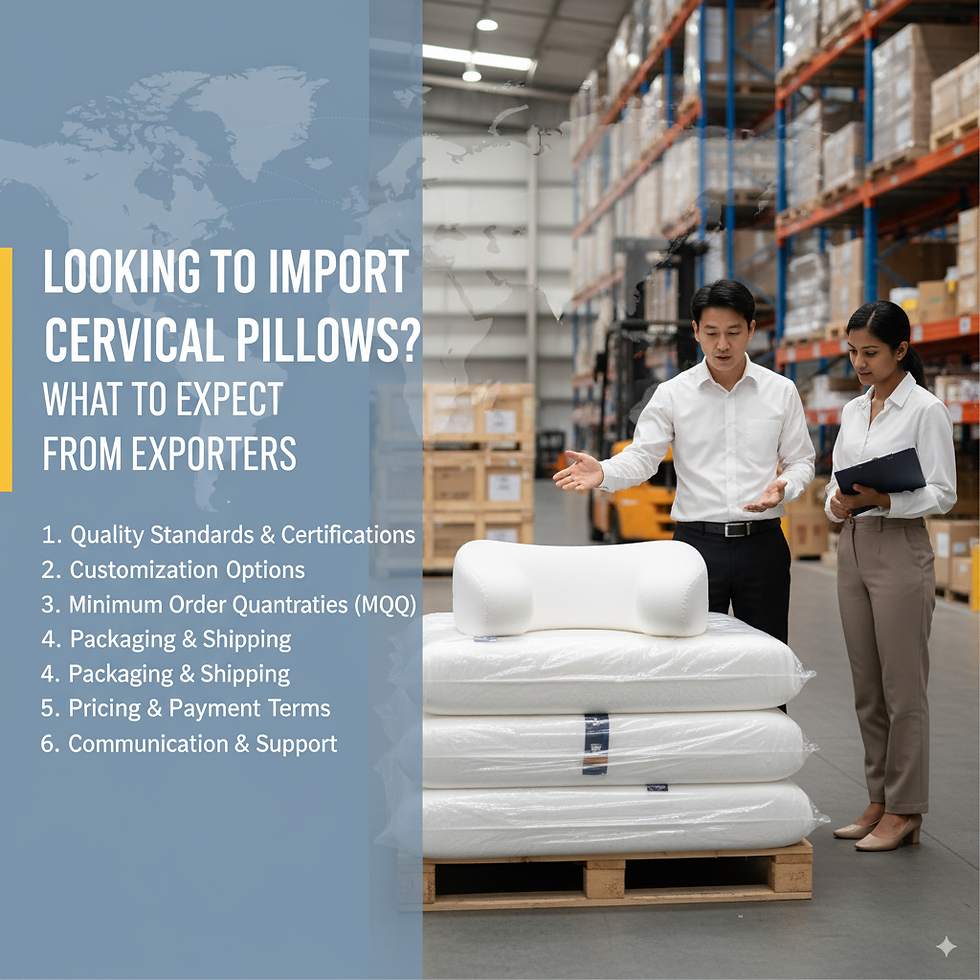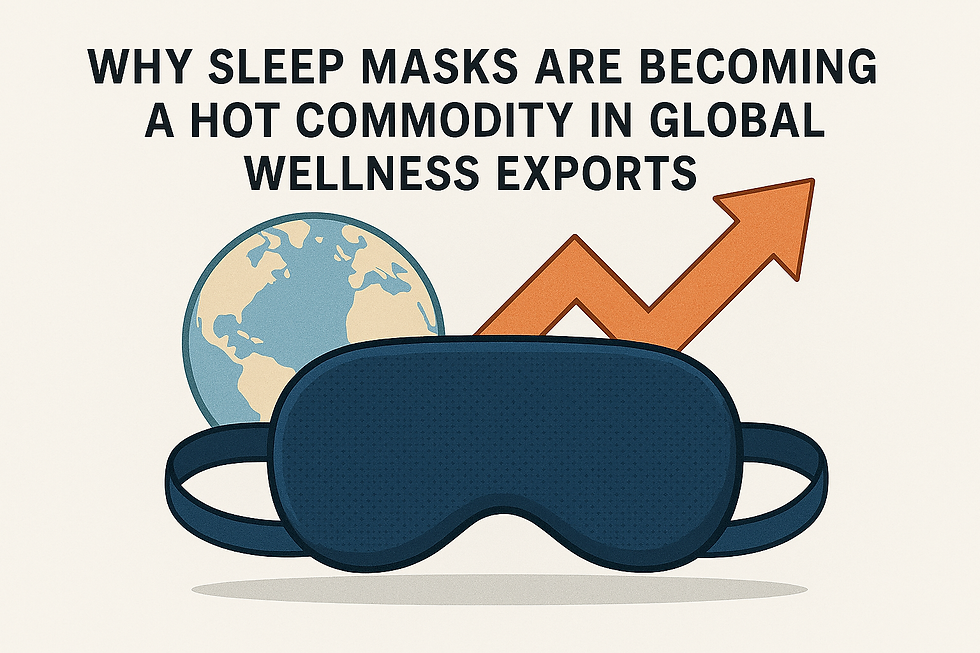Looking to Import Cervical Pillows? Here’s What to Expect from Exporters
- cdeastshore1
- Sep 10
- 4 min read

In today's health-conscious world, cervical pillows—also known as orthopedic or neck support pillows—are surging in popularity. Designed to alleviate neck pain, improve sleep posture, and support spinal alignment, these pillows cater to consumers dealing with everything from desk-job strains to travel discomforts. The global cervical pillows market is booming, projected to reach USD 6.0 billion by 2032, driven by rising demand for ergonomic sleep solutions. If you're a retailer, wholesaler, or e-commerce business looking to import these products, partnering with reliable exporters is key. But what should you expect? From sourcing hubs in Asia to navigating quality standards, pricing, and logistics, this guide breaks it down based on current market insights as of 2025. Whether you're eyeing bulk orders or private-label options, understanding exporter capabilities can help you avoid pitfalls and capitalize on this growing niche.
Understanding Cervical Pillows and the Import Landscape
Cervical pillows are contoured cushions typically made from memory foam, latex, or gel-infused materials, featuring a raised edge to cradle the neck and promote neutral spine alignment. They're essential for people with cervical spondylosis, headaches, or poor posture, and variants include travel-sized neck pillows for airplanes or cars. Importing them offers lucrative opportunities, especially as consumer awareness grows in markets like the U.S., where the segment is set to hit USD 1.89 billion by 2032.
The import landscape is dominated by Asian exporters. China leads globally, with hubs in Guangdong and Zhejiang provinces producing high volumes at competitive prices. Vietnam follows closely, benefiting from lower labor costs and shifting supply chains amid U.S.-China trade tensions. India and Turkey are emerging players, with India exporting over 150,000 pillow shipments annually, often focusing on eco-friendly materials like organic cotton covers. Other notable sources include Thailand and South Korea for specialized memory foam products. Exporters in these regions use platforms like Alibaba or Volza for B2B connections, providing detailed shipment data including buyers, suppliers, and pricing.
When engaging exporters, expect a mix of manufacturers (OEM/ODM) and trading companies. Top firms like those in Wuxi, China, offer diverse styles, from contoured orthopedic pillows to inflatable travel versions. Indian exporters, such as Hiakan International, emphasize medical-grade options with certifications. Vietnam's strength lies in rapid production scaling, though infrastructure challenges can affect timelines.
Quality Standards and Certifications to Anticipate
Quality is non-negotiable in health-related imports. Reputable exporters adhere to international standards like Oeko-Tex for textile safety (ensuring no harmful chemicals) and CertiPUR-US for foam purity, confirming low VOC emissions and durability. In Europe and the U.S., look for compliance with ISO 9001 for manufacturing processes and CE marking for safety. Chinese and Vietnamese suppliers often provide third-party testing reports from labs like SGS or Intertek.
Expect exporters to highlight material specs: high-density memory foam (40-60 kg/m³) for support, hypoallergenic covers, and antimicrobial treatments. However, challenges arise with counterfeit or low-quality imports, particularly from unregulated factories—Vietnam's market faces this issue, impacting trust. To mitigate, request samples and factory audits. Indian exporters may emphasize Ayurvedic-inspired designs with natural fillings, aligning with wellness trends.
In 2025, sustainability is a big draw. Many exporters use recycled foams or organic materials, complying with REACH regulations in the EU. U.S. importers should verify FDA compliance if pillows are marketed as medical devices, though most fall under general consumer goods.
Pricing, MOQs, and Customization Options
Pricing varies by origin and specs. Chinese exporters offer the lowest costs—wholesale prices range from $2-5 per unit for basic models, scaling to $10-20 for premium memory foam with custom branding. Vietnamese suppliers are competitive at $3-7, while Indian ones might charge $4-8, reflecting higher material standards. Factors like tariffs add 6-25% duties for U.S. imports under HS code 9404.90 (pillows and cushions). New U.S. tariffs on Chinese goods in 2025 could increase costs by 10-15%, pushing buyers toward Vietnam or India.
Minimum Order Quantities (MOQs) typically start at 500-1000 units for standard items, dropping to 200 for established buyers. Customization is a strong suit: exporters support private labeling, with options for logos, colors, firmness levels, and packaging. Chinese manufacturers like Union-Win excel in ODM services, allowing design tweaks for brand differentiation. Expect lead times of 30-60 days, influenced by seasonal demand peaks in Q4.
Shipping, Logistics, and Potential Challenges
Logistics can make or break imports. Exporters handle FOB or CIF terms, with shipping from ports like Shanghai (China), Hai Phong (Vietnam), or Mumbai (India). Container loads (20ft for 5,000+ units) are common, with freight costs $2,000-4,000 to the U.S. West Coast. Delays from port congestion in India or Vietnam's underdeveloped infrastructure are common—plan buffers.
Challenges include regulatory hurdles: U.S. Customs requires proper labeling (country of origin) and may inspect for flammability under CPSC standards. Vietnam's amended Quality Law emphasizes traceability, mandating digital passports for goods. Anti-dumping duties on related fibers from China/India could indirectly affect pricing. Intellectual property risks in China necessitate NDAs.
To navigate, use freight forwarders like Flexport for compliance. Currency fluctuations and supply chain disruptions (e.g., from geopolitical tensions) are ongoing concerns.
Tips for Successful Importing from Exporters
Vet Suppliers Thoroughly: Use Volza or Seair for trade data; visit factories virtually or in-person.
Negotiate Terms: Secure payment via L/C or escrow; insist on quality clauses.
Stay Compliant: Consult customs brokers for HS codes and duties—e.g., no quotas for most pillows post-China visa exemptions.
Diversify Sources: Blend China for volume, Vietnam for cost savings, India for premium eco-options.
Monitor Trends: With the market growing at 4.5% CAGR, focus on innovative features like cooling gels or adjustable fills.
Conclusion
Importing cervical pillows from exporters promises high margins in a market fueled by wellness and travel booms. Expect efficient production from Asian leaders, but prepare for quality checks, tariffs, and logistics hurdles. By partnering with certified suppliers and staying informed on regulations, you can build a thriving import business. As demand escalates—Asia-Pacific alone eyes USD 1.04 billion by 2024—now's the time to dive in. Research, sample, and scale wisely for success.



Comments